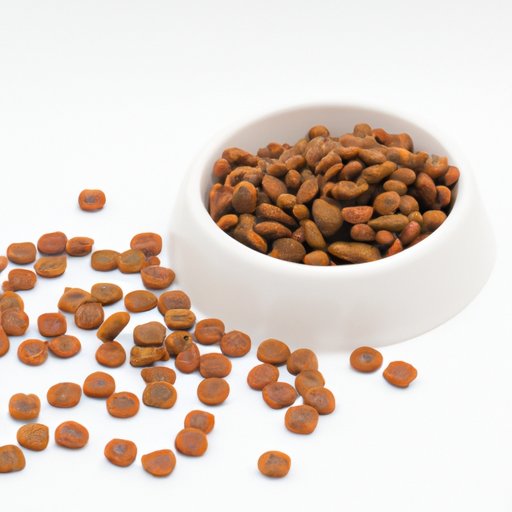
Introduction
As a dog owner, you want to provide the best care for your furry friend, and that includes choosing the right diet. Recently, grain-free dog food has become a trend among pet owners, but is it really the best choice for your dog? In this article, we will explore the pros and cons of a grain-free diet, discuss the nutritional needs of dogs, delve into the science behind grain-free dog food, and provide tips for switching your dog to a grain-free diet.
The Pros and Cons of a Grain-Free Diet for Dogs
Grain-free dog food has become increasingly popular among pet owners due to the perception of it being healthier for dogs. Grain-free dog food contains no wheat, corn, soy, or rice and often utilizes other carbohydrate sources, such as sweet potatoes.
One of the benefits of grain-free dog food is that it can improve dogs’ digestion and lead to fewer allergies. Grain can cause digestive issues for some dogs, as they lack the digestive enzymes necessary to break down complex carbohydrates. Additionally, some dogs have sensitivities to grains, so a grain-free diet can help reduce any allergic reactions.
However, there are potential drawbacks to a grain-free diet. Firstly, dogs on a grain-free diet may experience nutrient imbalances, as grains are a source of essential vitamins and minerals. Additionally, some dogs may experience digestive issues such as constipation or diarrhea when first transitioning to a grain-free diet. Lastly, grain-free food can be more expensive than regular dog food, which may be a concern for some pet owners.
Despite these potential drawbacks, many pet owners choose to feed their dogs a grain-free diet due to the perceived benefits it provides.
Understanding the Nutritional Needs of Your Dog
Dogs, like humans, require a balanced diet that provides them with all the necessary nutrients to remain healthy. This includes a balance of protein, carbohydrates, fats, vitamins, and minerals. A balanced diet for dogs varies depending on their age and lifestyle, so it is important to take these factors into account when choosing a diet for your dog.
So, where does grain-free dog food fit into a balanced diet? Grain-free dog food can be a suitable option as long as it includes all the necessary nutrients that dogs require. It’s important to note that grains aren’t the only source of carbs and fibers, and grain-free dog food recipes often substitute them with other carbs and fibers of similar nutritional value including sweet potatoes, peas, and legumes.
Grain-Free Dog Food: Is It Worth the Extra Cost?
The cost of grain-free dog food can be considerably higher than regular dog food because it uses higher-quality ingredients. While grain-free dog food may appear to be more expensive, it may provide several benefits that make it worth the cost. Grain-free dog food can contain higher-quality protein and healthier fats compared to regular dog food. Moreover, quality grains, such as brown rice, can be an essential part of a balanced diet, but it doesn’t mean all dog food with grains is nutritious.
So, is it worth the extra cost? The answer depends on the individual dog and their nutritional needs, so it is important to consider the pros and cons of a grain-free diet for your dog carefully.
The Science Behind Grain-Free Dog Food
Studies have been conducted to support both the benefits and drawbacks of grain-free dog food. Research which shows limiting grains in the diet of dogs can offer weight management benefits and improve the immune system of dogs that were previously allergic to grains. But, long-term feeding of grain-free dog food alone can result in nutritional imbalances or deficiencies that can affect a dog’s health.
It’s important to know how dog food labels are structured to make the most informed choices when it comes to selecting the right food for your pet. Therefore, when choosing dog food, pay more attention to protein sources, healthy fats, fiber instead of carbohydrates, and the nutritional adequacy statement. Different types of dog food will have different nutritional information and indications to guide consumers in making the right choices for their dogs.
Going Grain-Free: Tips for Making the Switch
When transitioning your dog to a grain-free diet, it is important to do so gradually to prevent any digestive issues. Start by mixing small amounts of grain-free dog food with your dog’s current food, and slowly increase the ratio of grain-free food over a week or two. During the transition, pay close attention to any changes in your dog’s digestion and adjust accordingly.
When choosing a high-quality grain-free dog food, look for one that includes a balance of protein, healthy fats, and necessary vitamins and minerals. Also, observe how your dog’s skin and coat, energy level, and weight respond to the new diet. Keep in touch with your veterinarian and seek advice if needed.
Conclusion
Feeding your dog a balanced diet is crucial for maintaining their health and well-being. Grain-free dog food can provide benefits such as improved digestion and fewer allergies. However, it may come with potential drawbacks such as nutrient imbalances and digestive issues. Choosing the right diet for your dog can be a complex process, but with the right information and guidance, you can make informed decisions that benefit your furry friend.
Remember to consult with a veterinarian before making any changes to your dog’s diet.





